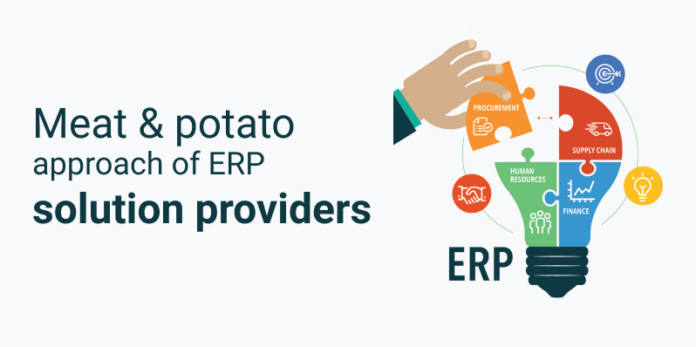Enterprise Resource Planning (ERP) systems provide multi-faceted solutions to companies. They enable organizations to increase their customer base, retain existing customers, destroy information silos, and help with other business-critical functions such as sales, manufacturing, finance, supply chain, human resource management, etc. ERP Software contributes in numerous ways to accelerate the growth of your company.
This article lists different ways in which an ERP system forms the meat and potato of your business.
1. The role of ERP systems in finance
Finance forms the core of any business. After all, companies function to earn profits. But this isn’t possible unless you reduce your expenditure. An ERP system, such as Sage 300Cloud, monitors your investments and keeps your finances in check.
The following are the features of the Sage 300Cloud finance module:
a. General Ledger
The general ledger allows you to post transactions from various sources and print reports, including trial balances, chart of accounts, transaction listings, and posting journals.
b. General ledger consolidation
Does your business have multiple entities? If yes, then the general ledger consolidation will generate critical financial reports for the corporate entity.
c. Accounts receivable
Sage 300Cloud allows you to send detailed invoices to your customers, track customer accounts, and produce transaction details whenever required.
d. Accounts payable
Sage 300Cloud allows you to create and maintain vendor accounts. It also enables you to print checks and enter or import transactions from multiple sources.
e. Intercompany transactions
Sage 300Cloud enables you to report results both ways — by the parent company or consolidated company. It also allows you to automate transactions for multiple entities.
f. Automatic trace
All transactions are logged automatically and timestamped, thereby allowing you to keep business-critical records audit-ready and compliant.
g. Instant bank reconciliation
Sage 300Cloud automates the monthly reconciliation process. It also detects unrecorded transactions and corrects dissimilarities between your bank account and your books.
2. The role of ERP systems in sales order management
The salespeople are known as frontline soldiers. They search for prospects, interact with them, and increase the revenue of the company. ERP systems increase the sales teams’ efficiency by providing a 360-degree perspective about fitting prospects and closing deals quickly.
The following are the features of Sage 300Cloud sales order management module:
a. Project and job costing
Sage 300Cloud enables companies to manage the time and related expenses of contractors and subcontractors and the original project status and timeline. This module easily integrates with “Microsoft Project,” allowing you to record costs, payables, and receivables of each project.
b. Purchase order
Sage 300Cloud enables you to automate purchase order procedures, such as requisitions, credit notes, vendor invoices, debit notes, purchase orders, receipts, etc. It also prints the procedures mentioned above, thereby saving time and reducing admin work.
c. Multiple contacts
Sage 300Cloud enables multiple stakeholders to collaborate in a single task and allows them to obtain customer details and respond through Microsoft Outlook.
d. Order entry
Sage 300Cloud allows companies to handle transactions from start to end. It enables the following:
i. Print invoices
ii. Print picking slips
iii. Print quotes
iv. Print order confirmations
v. Print shipping labels
It allows you to have a 360-degree perspective of your customer accounts and maintain adequate inventory levels. It integrates with job costing and helps sell merchandise that includes attributes like service, labor, and contacting costs.
3. The role of ERP systems in Customer Relationship Management
In the information age that we live in, people are well aware of what they want and where to get them. Customers are always in search of companies that sell the highest quality products at the lowest prices. Technology has only made this process quick and easy. Thus, to find new customers and expand the customer base, companies must invent ways of attracting prospects and providing top-notch customer service.
Sage 300cloud can be easily integrated with Sage CRM to provide first-class customer management services.
The following are the features of Sage CRM:
- Sage CRM will increase the efficiency of your support team. They will respond to customer queries faster and monitor every stage of the customer buying journey.
- Sage CRM will enable you to send targeted messages to your clients and allow you to extract business-critical information from them.
- Sage CRM maintains customer-centric information in a single repository and allows access to authorized stakeholders — frontline executives, C-suite executives, vendors, suppliers, distributors, etc.
- Sage CRM eliminates duplication of work and handles trivial jobs — form filling, report creation, payroll management, etc. — singlehandedly.
- Sage CRM breaks information silos by allowing business-critical information to travel from one department to another. Thus, it enables the company to work as a cohesive unit.
- Sage CRM provides real-time information that allows managers to brainstorm marketing strategies, identifying cross-sell and up-sell opportunities, and forecast tomorrow’s business conditions.
- Sage CRM creates reports rich with data, facts, and figures that provide better business insights and allow the management to identify new products and services are customers looking for.
4. The role of ERP systems in Inventory Management
Inventory management is a crucial aspect of any ERP system. It monitors the raw materials’ quantity that allows companies to function at their optimum capacity.
The following are the features of the Sage 300Cloud inventory management module:
- It creates and maintains inventory records so that you can easily track every transaction.
- It monitors the number of raw materials and places orders as soon as the quantity goes below the threshold level.
- It creates a list of vendors, suppliers, distributors, and updates them regularly.
- It produces reports that help you manage your stock quickly and efficiently.
- It generates lot/serial numbers that allow you to control/manage the stock. ERP systems consist of numerous built-in functions that allow companies to quicken their processes, increase their efficiency, and perform operations faster than ever. It takes control of trivial jobs to enable its human counterparts to execute activities that require human ingenuity.








